Top 10 Hypoallergenic Dogs For Allergy sufferers!

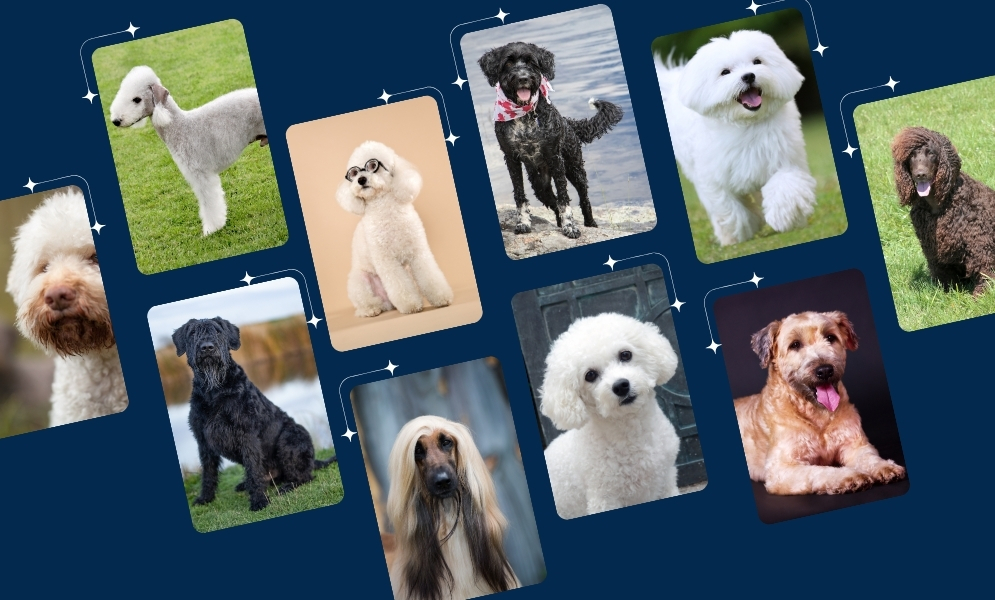
Dog allergies are a common issue, affecting millions of people worldwide. Symptoms can range from mild sniffling and itchy eyes to severe respiratory distress and asthma attacks.
The severity of an allergic reaction depends on various factors, including the individual’s sensitivity level, exposure duration, and the amount of allergen present.
The primary culprit behind dog allergies is a protein present in a dog’s dander, saliva, and urine. When these proteins become airborne, they can trigger an immune response in allergic individuals, leading to unpleasant symptoms.
So, if you’re an allergy sufferer, the term “hypoallergenic dogs” might sound like a dream come true for you. So, let’s get ready to meet some hypoallergenic dogs!
Why Should You Get a Hypoallergenic Dog?
Despite the challenges of dog allergies, many allergy sufferers still dream of owning a furry companion. Hypoallergenic dogs can be a good solution to their dilemma. These are breeds that are less likely to trigger allergic reactions in people who are sensitive to pet dander, saliva, or hair.
However, it’s important to note that no dog is truly 100% hypoallergenic. The term simply refers to breeds that produce less of the proteins that cause allergic reactions in humans. As we mentioned before, the main cause of dog allergy is a type of protein that is present in their dander (dead skin cells), saliva, and urine.
Some breeds shed less fur and produce less dander, making them more suitable for allergy sufferers. While no dog is completely allergen-free, hypoallergenic breeds allow allergy sufferers to experience the joy of pet ownership while minimizing the risk of severe allergic reactions.
Factors to Consider When Choosing a Hypoallergenic Dog
While hypoallergenic dogs can be a great option for allergy sufferers, it’s essential to consider several factors before deciding. Here are some key considerations:
- The severity of your allergies: If you have severe allergies, it’s crucial to consult with an allergist or veterinarian to determine the best breed for your specific condition.
- Grooming requirements: Many hypoallergenic breeds require regular grooming to minimize shedding and dander production. Ensure you have the time and resources to maintain their grooming needs.
- Exercise and activity levels: Different breeds have varying energy levels and exercise requirements. Choose a breed that aligns with your lifestyle and activity preferences.
- Living space: You should consider the size of your living space. Additionally, try to find out if the dog breed you want can comfortably adapt to your living situation or not.
The Top 10 Hypoallergenic Dog Breeds
Now you know what causes dog allergy and the factors to consider while choosing a hypoallergenic dog. So, let’s explore the top 10 breeds that are comparatively more allergy-friendly than most other dog breeds.
Poodle (Standard, Miniature, and Toy)
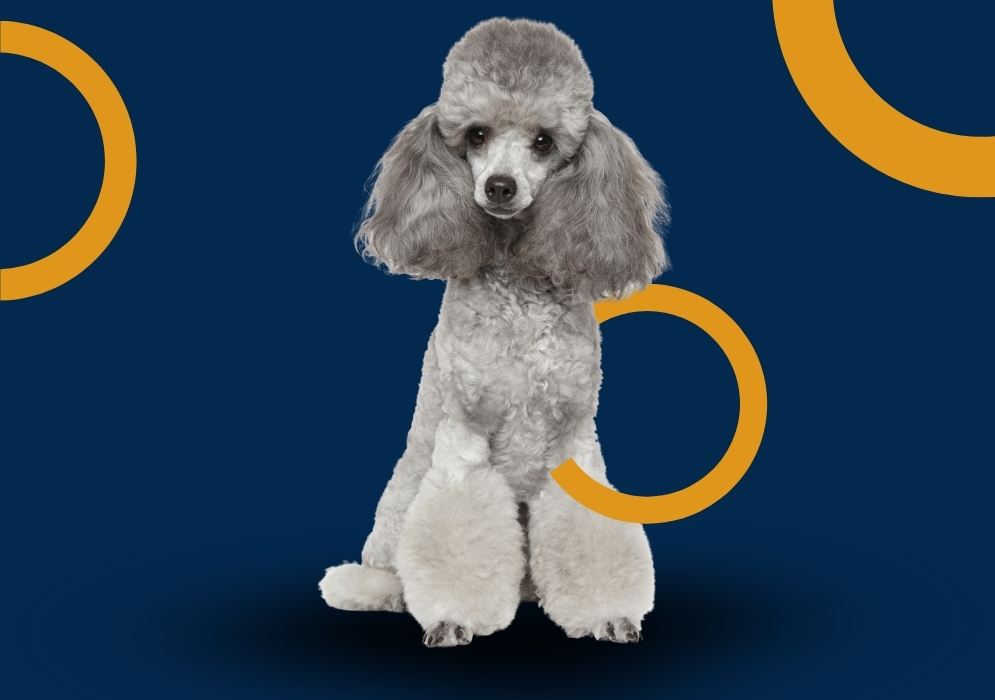
Poodles are the gold standard for hypoallergenic dogs. They have a unique, curly, and low-shedding coat that sheds very little. The dense, curly hair also traps dander and stops it from becoming airborne. Compared to other dog breeds, Poodles produce fewer allergenic proteins in their skin and saliva.
In addition, Poodles are intelligent, active, and make excellent companions. It is because of their versatility, they perform various roles, such as service and therapy dogs.
| Key Points | Description |
| Breed Name | Poodle |
| County of Origin | Germany |
| Height | Toy: Up to 10 inches; Miniature: 10 to 15 inches; Standard: Over 15 inches |
| Weight | Toy: 4 to 6 pounds; Miniature: 10 to 15 pounds; Standard: 40 to 70 pounds |
| Coat Type and Color | Curly, long coat; Colors: Apricot, black, blue, brown, cafe au lait, cream, gray, red, silver, silver beige, white |
| Lifespan | 10 to 18 years |
| Temperament | Intelligent, affectionate, active |
| Exercise Needs | High; requires regular physical and mental stimulation |
| Grooming Needs | High; requires regular grooming to prevent matting and maintain coat health |
Portuguese Water Dog
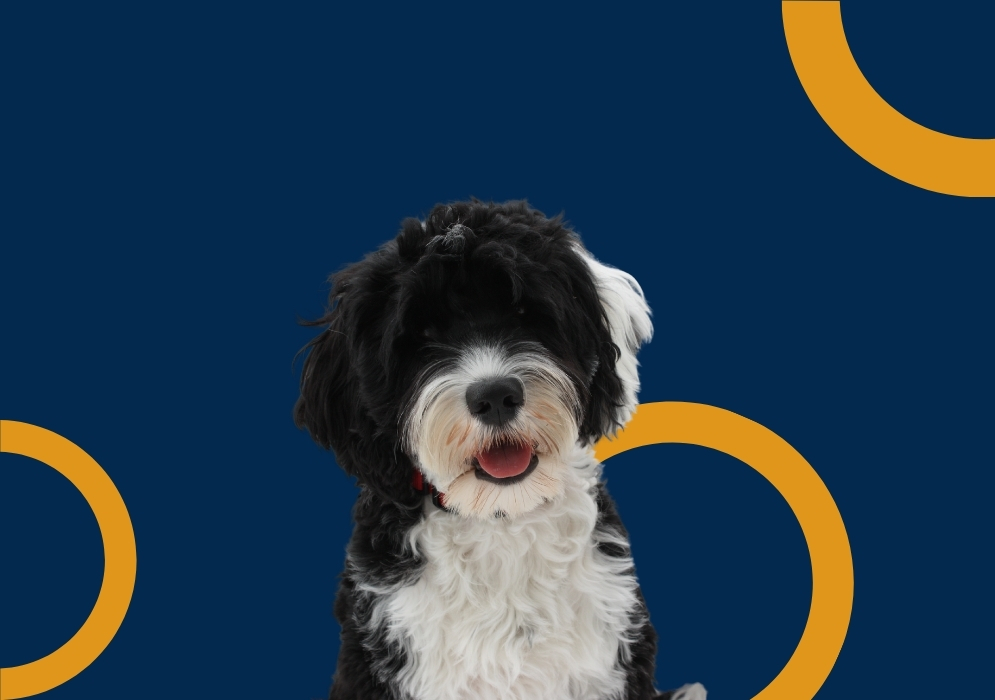
Originally bred as a working dog, the Portuguese Water Dog has a hypoallergenic, curly coat. They are known for their exceptional swimming abilities and were historically used by fishermen to herd fish into nets and retrieve lost tackles. They are great companions for active families and individuals.
| Key Points | Description |
| Breed Name | Portuguese Water Dog |
| County of Origin | Portugal |
| Height | 17 to 23 inches |
| Weight | 35 to 60 pounds |
| Coat Type and Color | Curly or wavy coatColors: Black, brown, black or brown with white markings |
| Lifespan | 11 to 14 years |
| Temperament | Intelligent, energetic, affectionate, and loyal |
| Exercise Needs | High; requires regular physical activity and mental stimulation |
| Grooming Needs | High; requires regular grooming to maintain coat health and prevent matting |
Giant Schnauzer
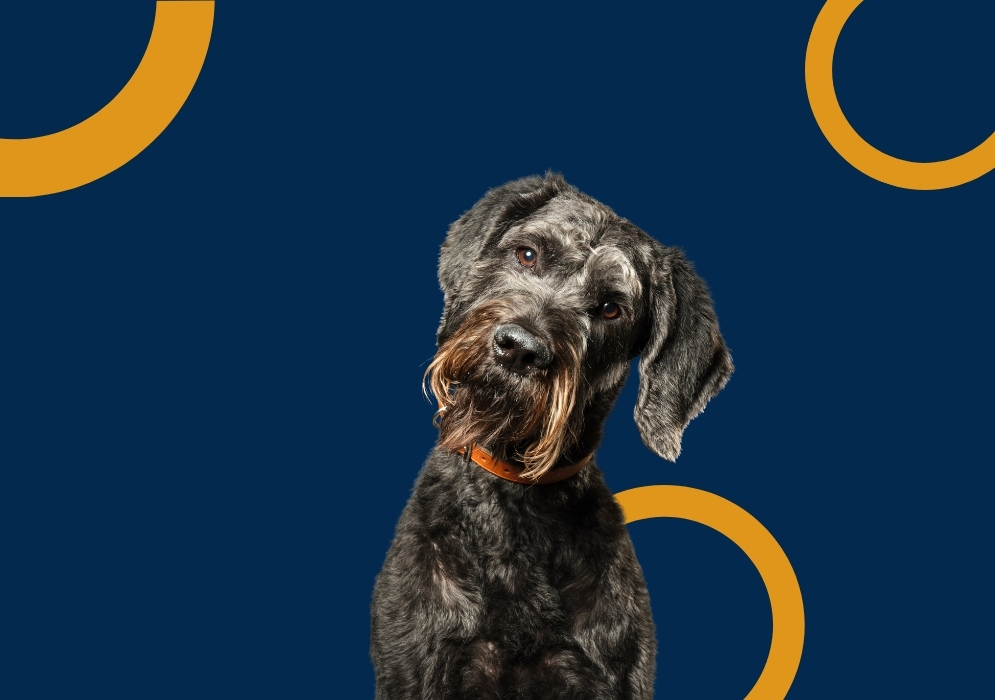
The Giant Schnauzer is a larger breed known for its distinctive beard and mustache that makes them look wise and responsible. They were originally bred in Germany for herding cattle and guarding livestock. Later on, their duties also expanded to include roles in police and military work.
They also make excellent watchdogs. It is their history as a working dog and their intelligence and trainability that enables them to excel in all their roles.
Their wiry, low-shedding coat makes them a good choice for allergy sufferers. The standard and the miniature schnauzer versions are also considered hypoallergenic.
| Key Points | Description |
| Breed Name | Giant Schnauzer |
| County of Origin | Germany |
| Height | 23.5 to 27.5 inches |
| Weight | 55 to 95 pounds |
| Coat Type and Color | Dense, wiry double coat<br>Colors: Solid black, pepper and salt |
| Lifespan | 10 to 12 years |
| Temperament | Intelligent, loyal, protective, and energetic |
| Exercise Needs | High; requires vigorous daily exercise and mental stimulation |
| Grooming Needs | High; requires regular brushing and professional grooming to maintain coat health and prevent matting |
Afghan Hound
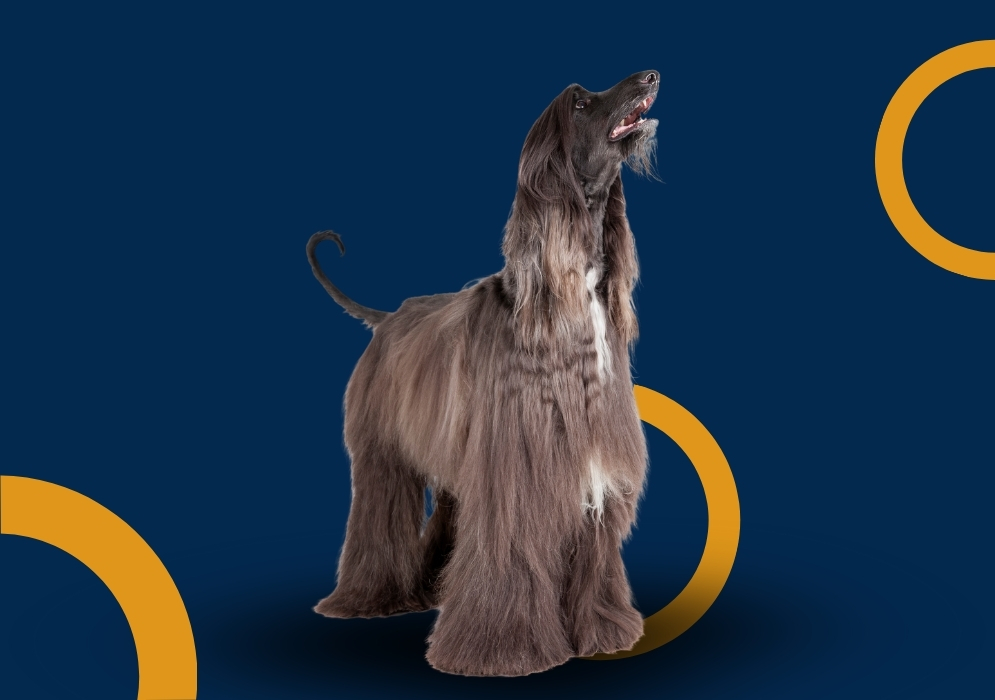
Afghan Hounds are known for their elegant appearance and independent and dignified nature. Initially bred by the bedouin people, these dogs go back thousands of years and were used for hunting in the mountainous regions of Afghanistan, which explains their agility and endurance.
These dogs have a long, silky coat that produces minimal dander and are therefore great for people with allergies. Afghan Hounds have a distinctive topknot of long hair on their heads and a ring curl at the end of their tails.
| Key Points | Description |
| Breed Name | Afghan Hound |
| County of Origin | Afghanistan |
| Height | 25 to 27 inches |
| Weight | 50 to 60 pounds |
| Coat Type and Color | Long, silky coat; Colors: Black, black & tan, blue, blue & cream, cream, red, silver, white, and more |
| Lifespan | 12 to 14 years |
| Temperament | Aloof, dignified, independent, and sometimes clownish |
| Exercise Needs | High; requires regular physical activity and mental stimulation |
| Grooming Needs | High; requires regular grooming, including weekly baths and brushing to prevent matting and tangling |
Maltese
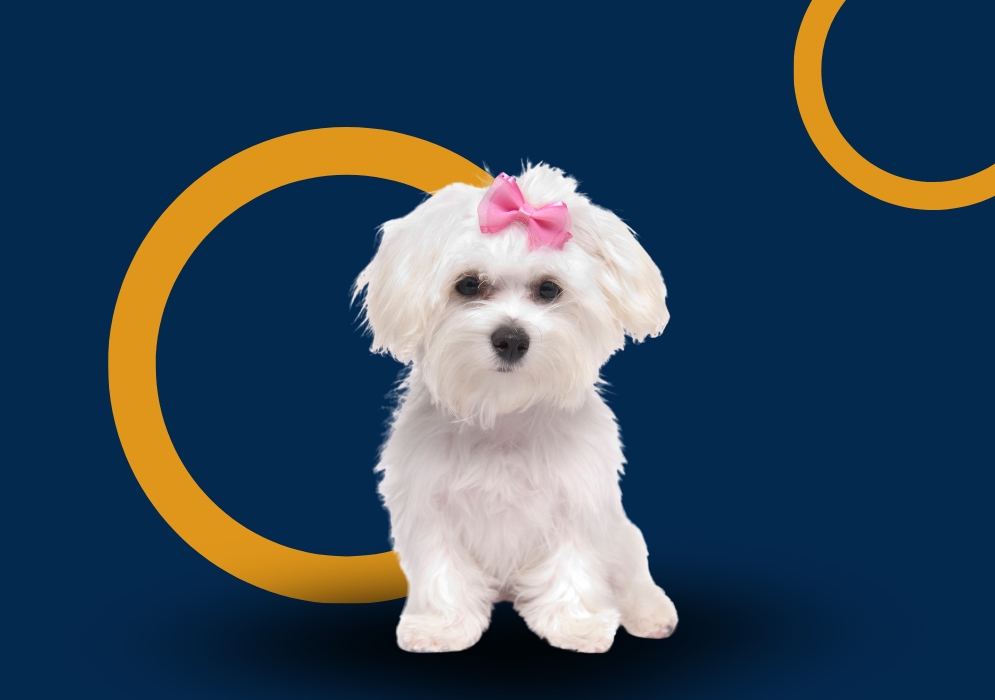
The Maltese is a small, gentle breed with a long, silky coat that sheds minimally. They are affectionate, playful, and adapt well to apartment living.
| Key Points | Description |
| Breed Name | Maltese |
| County of Origin | Mediterranean region, specifically the island of Malta |
| Height | 7 to 9 inches |
| Weight | Up to 7 pounds |
| Coat Type and Color | Long, silky coat Color: Pure white |
| Lifespan | 12 to 15 years |
| Temperament | Gentle, affectionate, intelligent, playful, and lively |
| Exercise Needs | Moderate; enjoys short walks and playtime |
| Grooming Needs | High; requires regular brushing and grooming to maintain coat health and prevent matting |
Soft-Coated Wheaten Terrier
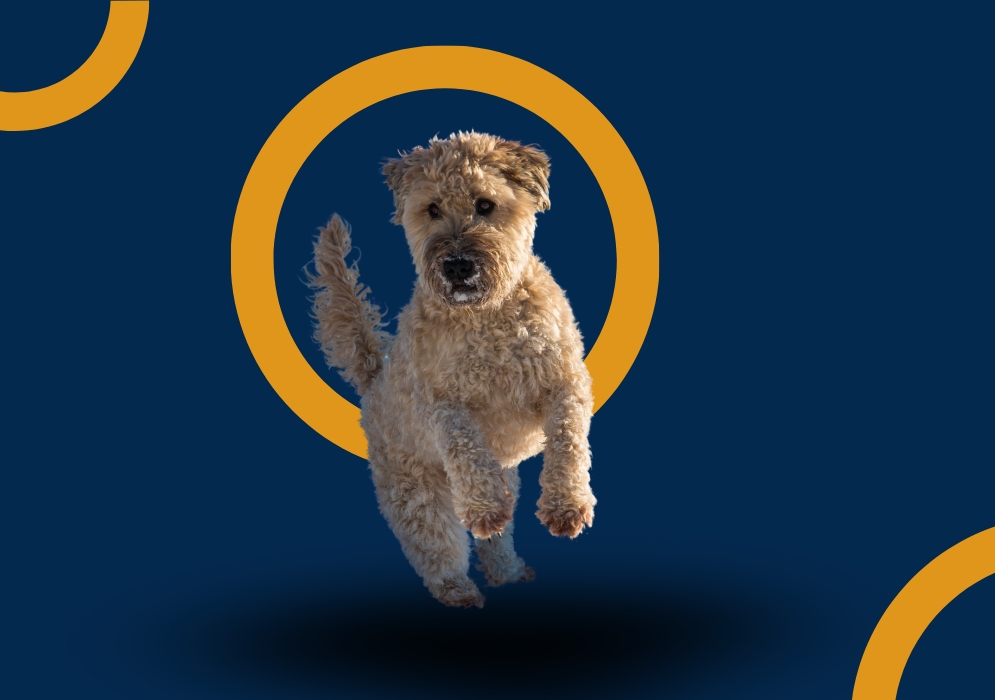
The Soft-Coated Wheaten Terrier has a unique, soft, and hypoallergenic coat. They are friendly, energetic, and make excellent family companions.
| Key Points | Description |
| Breed Name | Soft-Coated Wheaten Terrier |
| County of Origin | Ireland |
| Height | 17 to 19 inches |
| Weight | 30 to 40 pounds |
| Coat Type and Color | Wavy, silky, medium-length coat; Color: Wheaten (gold) |
| Lifespan | 12 to 14 years |
| Temperament | Friendly, lively, affectionate, and playful |
| Exercise Needs | High; requires regular physical activity and mental stimulation |
| Grooming Needs | High; requires regular grooming to maintain coat health and prevent matting |
Bichon Frise
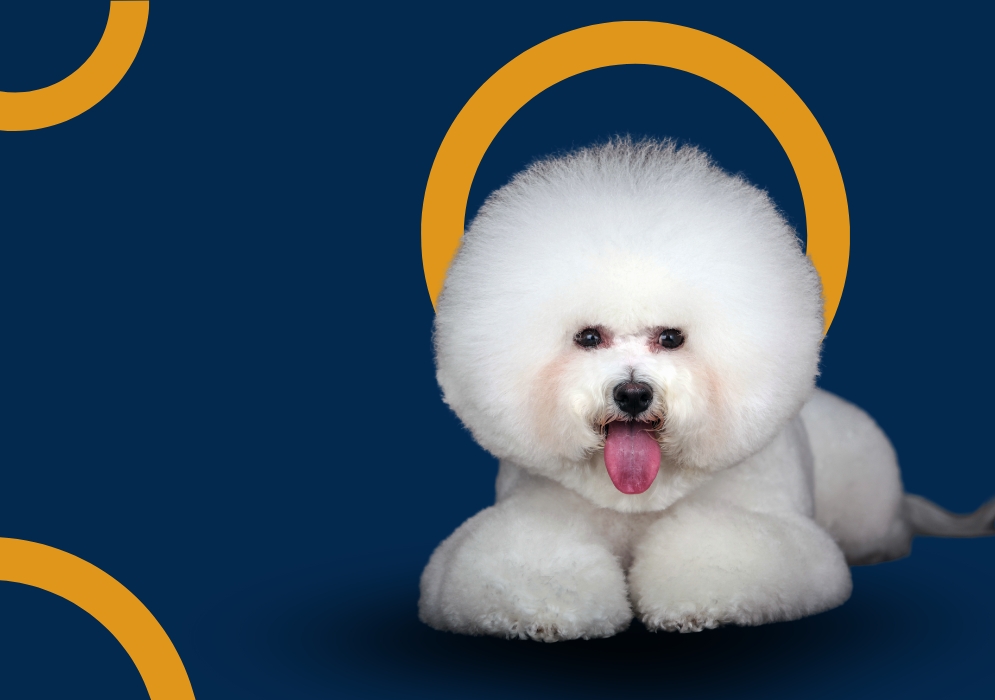
Bichon Frises are known for their charming personalities and hypoallergenic coats. This makes them great companions for families and individuals suffering from allergies.
| Key Points | Description |
| Breed Name | Bichon Frise |
| County of Origin | Mediterranean region, specifically Spain and Italy |
| Height | 9.5 to 11.5 inches |
| Weight | 12 to 18 pounds |
| Coat Type and Color | Curly, double coat; Color: White, sometimes with shades of apricot, buff, or cream |
| Lifespan | 14 to 15 years |
| Temperament | Playful, affectionate, cheerful, and gentle |
| Exercise Needs | Moderate; enjoys daily walks and playtime |
| Grooming Needs | High; requires regular grooming, including brushing and trimming to maintain coat health and prevent matting |
Irish Water Spaniel
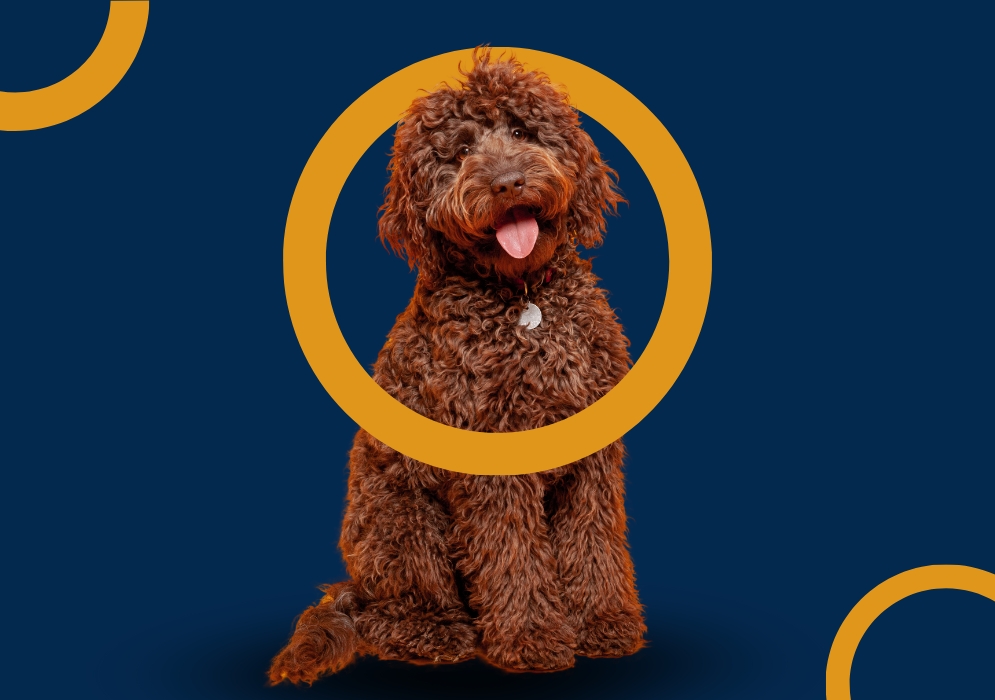
As the name suggests, Irish Water Spaniel originated from Ireland. They are one of the oldest and rarest spaniel breed. This breed was developed in the 19th century by crossing various water spaniels. Their main purpose was to use them for retrieving game from water, thanks to their excellent swimming skills.
Additionally, the Irish Water Spaniel have a dense, curly, liver-colored coat that is water-resistant and hypoallergenic. But the drawback is that their coat requires a lot of grooming to prevent matting.
| Key Points | Description |
| Breed Name | Irish Water Spaniel |
| County of Origin | Ireland |
| Height | 21 to 24 inches |
| Weight | 45 to 68 pounds |
| Coat Type and Color | Curly, dense, water-resistant coat; Color: Liver (brown) |
| Lifespan | 12 to 13 years |
| Temperament | Playful, affectionate, loyal, intelligent, and eager to please |
| Exercise Needs | High; requires vigorous daily exercise and enjoys activities like swimming and fetching |
| Grooming Needs | High; requires regular grooming to maintain coat health and prevent matting |
Bedlington Terrier
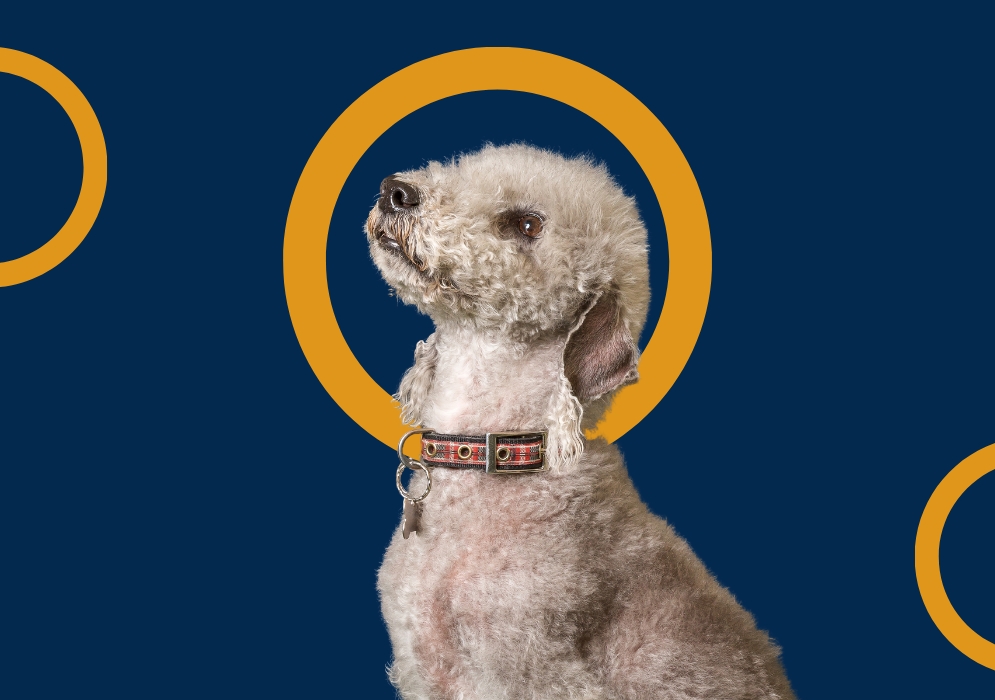
Bedlington Terriers are popular for their unique lamb-like appearance and lively personality. This is mainly due to the fact that these Terriers have a distinctive, wool-like coat that sheds minimally. In addition to their adorable looks, Bedlington Terriers are great as family pets, because they are protective and affectionate with their loved ones.
| Key Points | Description |
| Breed Name | Bedlington Terrier |
| County of Origin | England |
| Height | 15 to 17.5 inches |
| Weight | 17 to 23 pounds |
| Coat Type and Color | Curly, woolly coat; Colors: Blue, liver, sandy, and combinations with tan |
| Lifespan | 12 to 14 years |
| Temperament | Affectionate, energetic, intelligent, and loyal |
| Exercise Needs | High; requires regular physical activity and mental stimulation |
| Grooming Needs | High; requires regular grooming every 6-8 weeks to maintain coat health and prevent matting |
Lagotto Romagnolo
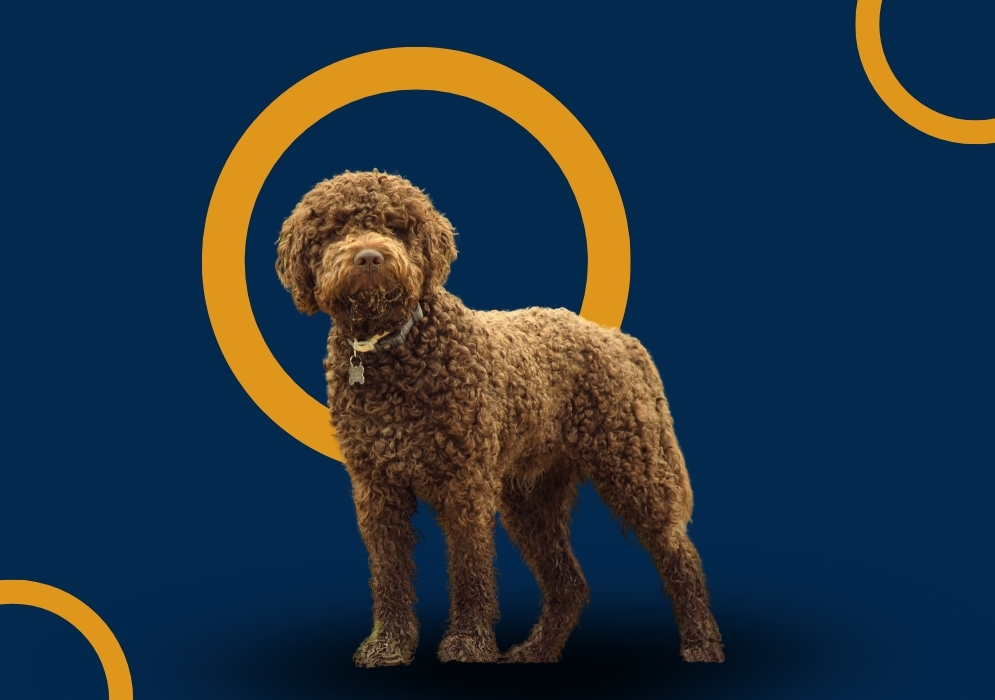
It is thought that the Lagotto Romagnolo dog breed has existed for around for thousands of years. They hail from the Romagna region in Northern Italy. Originally, the breed was used for waterfowl hunting. Then in the 19th century, these dogs were slowly transitioned to hunting for truffles, a role they excelled at due to their excellent sense of smell. These dogs are intelligent, affectionate and make great companions for active families and individuals.
| Key Points | Description |
| Breed Name | Lagotto Romagnolo |
| County of Origin | Italy |
| Height | 16 to 19 inches |
| Weight | 24 to 35 pounds |
| Coat Type and Color | Curly, dense, water-resistant coat; Colors: Brown, orange, white, and combinations of these colors |
| Lifespan | 11 to 14 years |
| Temperament | Lively, affectionate, intelligent, and eager to please |
| Exercise Needs | Moderate to high; enjoys activities like running, jumping, swimming, and fetching |
| Grooming Needs | Moderate to high; requires regular grooming to maintain coat health and prevent matting |
Tips for Caring for Hypoallergenic Dogs and Reduce Allergens in Your Home
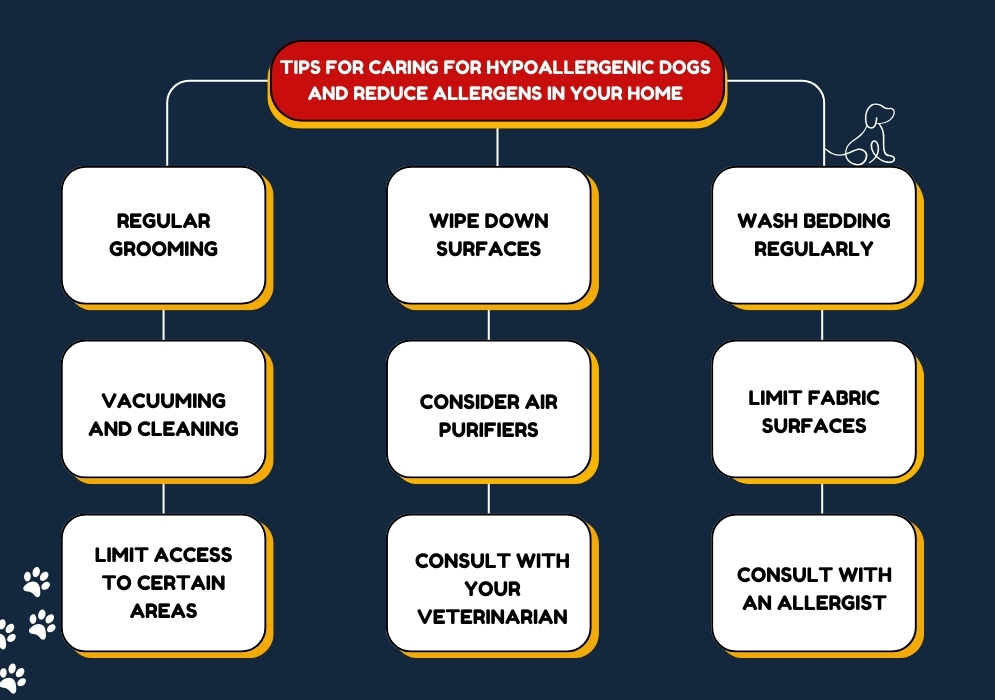
While hypoallergenic dogs can be a great option for allergy sufferers, proper care and maintenance are crucial to minimize allergen exposure.
Here are some tips to help reduce allergens and create a more allergy-friendly environment:
Regular grooming
Most hypoallergenic breeds require regular grooming to remove loose hair, dander, and other allergens from their coat. Hence you should brush, bathe, and trim your dog as frequently as possible to reduce allergens in your home.
Vacuuming and cleaning
Frequently Vacuum and clean your living spaces, including your carpet and furniture, to remove any loose pet hair or dander.
Limit access to certain areas
Restrict your dog’s access to certain rooms or areas of your home, such as bedrooms, to minimize allergen exposure in those spaces.
Wipe down surfaces
Regularly wipe down surfaces, including furniture and floors, to remove any accumulated dander or hair.
Consider air purifiers
Air purifiers with HEPA (high-efficiency particulate air) filters can help remove airborne allergens, including pet dander, from your living spaces.
Wash bedding regularly
Wash your bedding, including sheets, pillowcases, and blankets, in hot water weekly to eliminate allergens.
Limit fabric surfaces
Opt for hard, non-porous surfaces that are easier to clean and less likely to accumulate allergens.
Consult with an allergist
If you have severe allergies, consult with an allergist to develop a comprehensive plan for managing your symptoms and minimizing allergen exposure.
Remember, no dog is truly 100% hypoallergenic. But some dog breeds sport low-shedding coat which means less dander. This can significantly reduce the severity of allergic symptoms, allowing you to experience the joys of pet ownership.
Consequently, if you’re an allergy sufferer considering getting a hypoallergenic dog breed. We also highly recommend consulting with a veterinarian or allergist to determine the best hypoallergenic dogs for your specific needs.






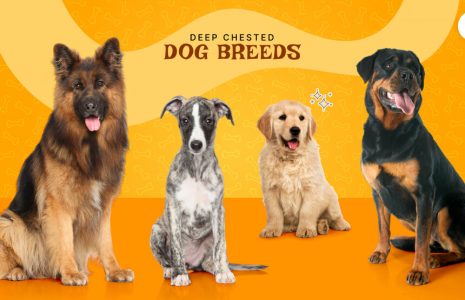
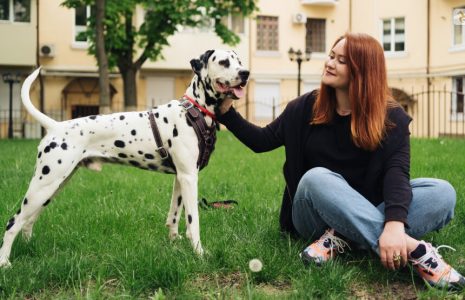
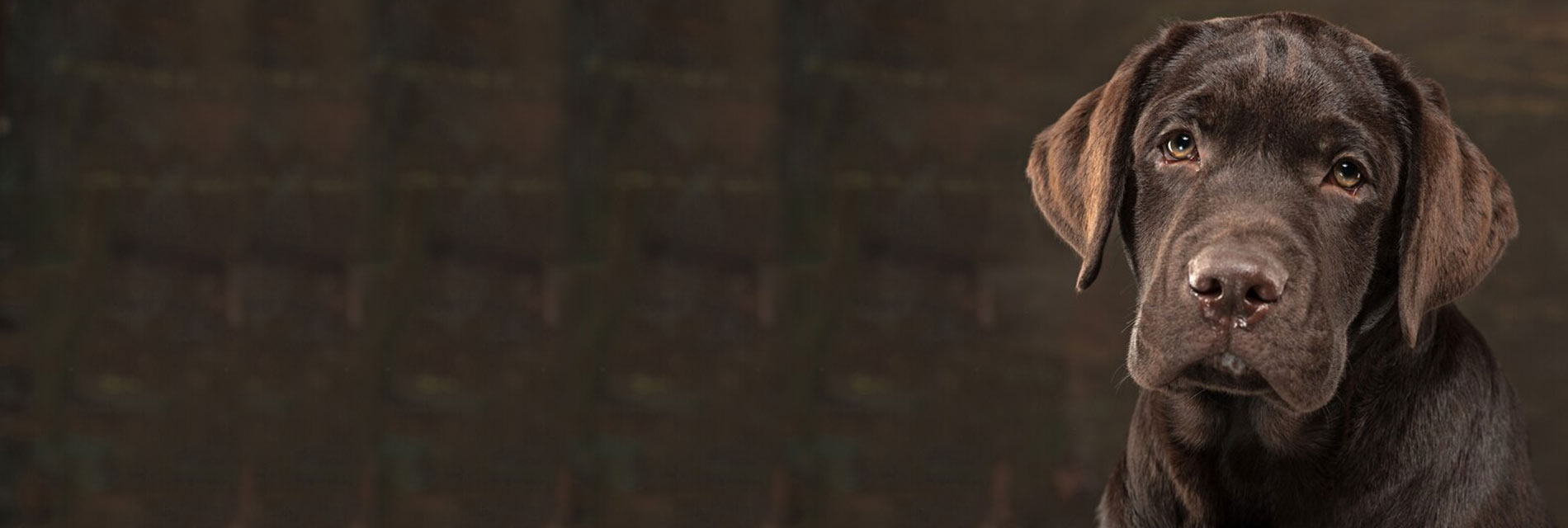
Leave A Comment